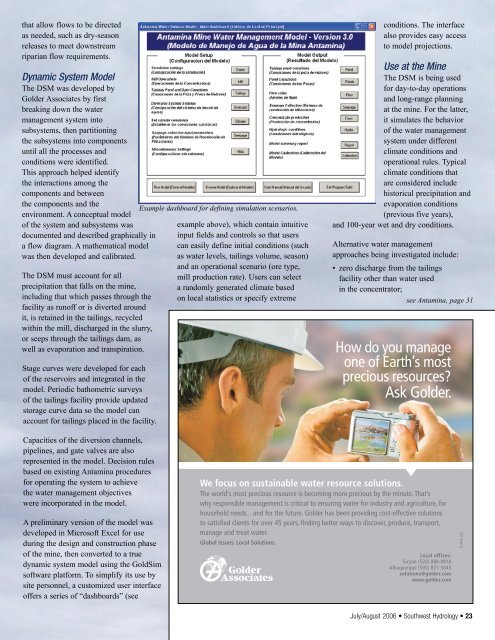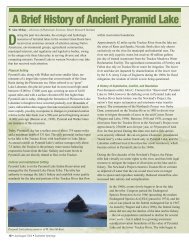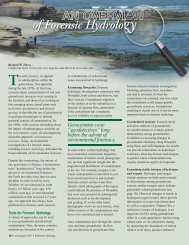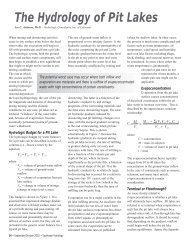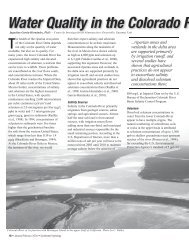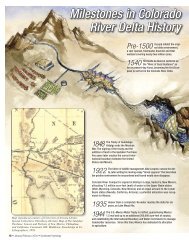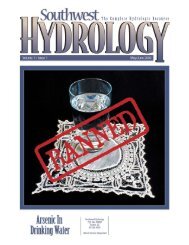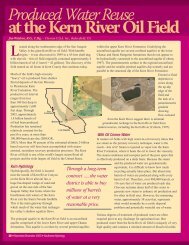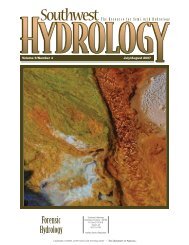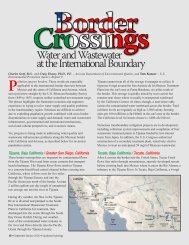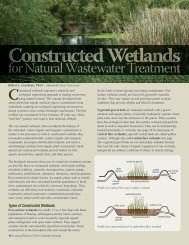Peruvian Mine Operation Using Dynamic System Modeling Charlie ...
Peruvian Mine Operation Using Dynamic System Modeling Charlie ...
Peruvian Mine Operation Using Dynamic System Modeling Charlie ...
You also want an ePaper? Increase the reach of your titles
YUMPU automatically turns print PDFs into web optimized ePapers that Google loves.
that allow flows to be directed<br />
as needed, such as dry-season<br />
releases to meet downstream<br />
riparian flow requirements.<br />
<strong>Dynamic</strong> <strong>System</strong> Model<br />
The DSM was developed by<br />
Golder Associates by first<br />
breaking down the water<br />
management system into<br />
subsystems, then partitioning<br />
the subsystems into components<br />
until all the processes and<br />
conditions were identified.<br />
This approach helped identify<br />
the interactions among the<br />
components and between<br />
the components and the<br />
environment. A conceptual model<br />
of the system and subsystems was<br />
documented and described graphically in<br />
a flow diagram. A mathematical model<br />
was then developed and calibrated.<br />
The DSM must account for all<br />
precipitation that falls on the mine,<br />
including that which passes through the<br />
facility as runoff or is diverted around<br />
it, is retained in the tailings, recycled<br />
within the mill, discharged in the slurry,<br />
or seeps through the tailings dam, as<br />
well as evaporation and transpiration.<br />
Stage curves were developed for each<br />
of the reservoirs and integrated in the<br />
model. Periodic bathometric surveys<br />
of the tailings facility provide updated<br />
storage curve data so the model can<br />
account for tailings placed in the facility.<br />
Example dashboard for defining simulation scenarios.<br />
example above), which contain intuitive<br />
input fields and controls so that users<br />
can easily define initial conditions (such<br />
as water levels, tailings volume, season)<br />
and an operational scenario (ore type,<br />
mill production rate). Users can select<br />
a randomly generated climate based<br />
on local statistics or specify extreme<br />
conditions. The interface<br />
also provides easy access<br />
to model projections.<br />
Use at the <strong>Mine</strong><br />
The DSM is being used<br />
for day-to-day operations<br />
and long-range planning<br />
at the mine. For the latter,<br />
it simulates the behavior<br />
of the water management<br />
system under different<br />
climate conditions and<br />
operational rules. Typical<br />
climate conditions that<br />
are considered include<br />
historical precipitation and<br />
evaporation conditions<br />
(previous five years),<br />
and 100-year wet and dry conditions.<br />
Alternative water management<br />
approaches being investigated include:<br />
• zero discharge from the tailings<br />
facility other than water used<br />
in the concentrator;<br />
see Antamina, page 31<br />
<br />
<br />
<br />
<br />
Capacities of the diversion channels,<br />
pipelines, and gate valves are also<br />
represented in the model. Decision rules<br />
based on existing Antamina procedures<br />
for operating the system to achieve<br />
the water management objectives<br />
were incorporated in the model.<br />
A preliminary version of the model was<br />
developed in Microsoft Excel for use<br />
during the design and construction phase<br />
of the mine, then converted to a true<br />
dynamic system model using the GoldSim<br />
software platform. To simplify its use by<br />
site personnel, a customized user interface<br />
offers a series of “dashboards” (see<br />
<br />
<br />
<br />
<br />
<br />
<br />
<br />
<br />
<br />
<br />
<br />
<br />
<br />
July/August 2006 • Southwest Hydrology • 23


